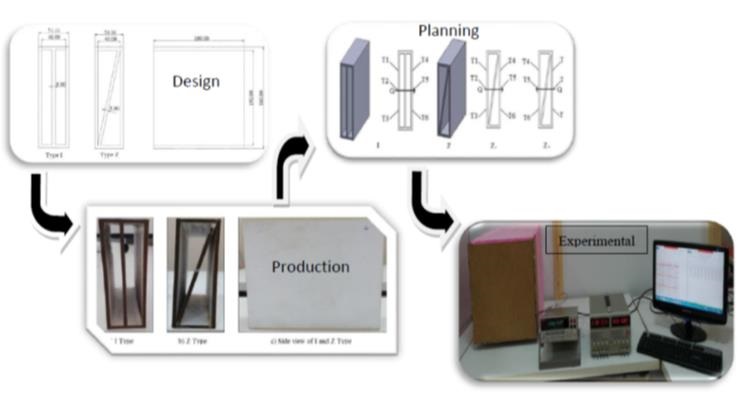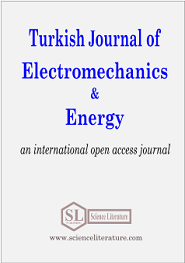
An experimental study on the overall heat transfer coefficient of various wall brick models
Abstract
It is well known that most of the heat losses of buildings occur at outer walls, which are made of a few layers such as plaster, wall bricks, insulation material, etc. It is required that the wall bricks having a low overall heat transfer coefficient to reduce heat losses through buildings to increase the heating performance of buildings. In order to address the requirement, the wall bricks are produced of low thermal conductivity materials and with cavities (hole), weakening the thermal transport mechanism. This study, is aimed to decrease the overall heat transfer coefficient of wall brick models with various cavities, which affect the natural convection mechanism. For this purpose, some changes are made to the cavity geometry of a single cell of the hollow wall brick model. The proposed geometries' heat transfer experiments were repeated under three different (7, 9, 12 W) thermal power conditions. The building is simulated as an insulated chamber made of extruded polystyrene (XPS) with 300 mm x 300 mm x 300 mm. The wall brick models are produced from polyvinyl chloride (PVC) material in 160 mm x 160 mm x 50 mm and mounted to a wall of the insulated chamber. The experiments are carried out on the brick models with the cavity geometries of regular symmetrical I and asymmetrical Z profiles. The temperatures are measured at 3 points on both sides of the brick models. It has been measured that the overall heat transfer coefficient of the Z model is lower than that of the regular I profile at 7.1%, depending on the heat transfer direction.
Full Text:
PDFReferences
F. P. Incropera, D. P. Dewitt, T. L. Bergman, A. S. Lavine, Principles of Heat and Mass Transfer, Seventh Edition, Wiley, 2013.
M. M. Al-Hamza, “Analysis of coupled natural convection-conduction effects on the heat transport through hollow building blocks,” Energy and Buildings, vol. 38, pp. 515-521, 2006.
T. Ait-Taleb, A. Abdelbaki, & Z. Zrikem, “Simulation of coupled heat transfers in a hollow tile with two vertical and three horizontal uniform rectangular cavities heated from below or above,” Energy and Buildings, vol. 84, pp. 628-632, 2014.
M. E. Arıcı, F. E. Kan, A. E. Candemir, & E. Özkan, “Eşit boyutlu olmayan ardışık boşluklara sahip bir tuğlada ısı transferi, 22th Congress on Thermal Science and Technology, Kocaeli-Turkey, vol. 1, pp. 309-319, 2019.
D. Gossard, & B. Lartigue, “Three-dimensional conjugate heat transfer in partitioned enclosures: determination of geometrical and thermal properties by inverse method,” Applied Thermal Engineering, vol. 54, pp. 549-558, 2013.
J. Vivancos, J. Soto, I. Perez, J. V. Ros-Lis, & R. Martinez-Manez, “A new model based on experimental results for the thermal characterization of bricks,” Building and Environment, vol. 44, pp. 1047-1052, 2009.
J. Sun, L. Fang, J. Han, “Optimization of concrete hollow brick using hybrid genetic algorithm combining with artificial neural networks,” International Journal of Heat and Mass Transfer, vol. 53, pp. 5509-5518, 2010.
K. Arendt, M. Krzaczek, & J. Florczuk, “Numerical analysis by FEM and analytical study of the dynamic thermal behaviour of hollow bricks with different cavity concentration,” International Journal of Thermal Sciences, vol. 50, pp. 1543-1553, 2011.
M. E. Arıcı, & F. E. Kan, “A numerical investigation of tilted holes effects on overall thermal resistance for a masonry brick,” 13th HVAC+R Technologies Symposium, İstanbul, 19-25, 2018.
B. Jamal, M. Boukendil, L. El Moutaouakil, A. Abdelbaki, Z. Zrikem, “Thermal analysis of hollow clay bricks submitted to a sinusoidal heating,” Materials Today: Proceedings, vol. 45, pp. 7399-7403, 2021.
G. Jia, X. Geng, F. Liu, Y. Gao, “Thermal behavior improvement of hollow sintered bricks integrated with both Thermal Insulation Material (TIM) and Phase-Change Material (PCM), Case Studies in Thermal Engineering, vol. 25, 100938, 2021.
M. P. Morales, M. C., Juarez, L. M. Lopez-Ochoa, & J. Domenech, “Study of the geometry of a voided clay brick using rectangular perforations to optimize its thermal properties,” Applied Thermal Engineering, vol. 31, pp. 2063-2065, 2011.
S. J. Kline, & F. A. McClintock, “Describing Uncertainties Sample Experiments,” Mechanical Engineering, 1953.
URN: https://sloi.org/urn:sl:tjoee62185
Copyright (c) 2021 Turkish Journal of Electromechanics and Energy

This work is licensed under a Creative Commons Attribution-NonCommercial 4.0 International License.

 Indexed in:
Indexed in:
















